.
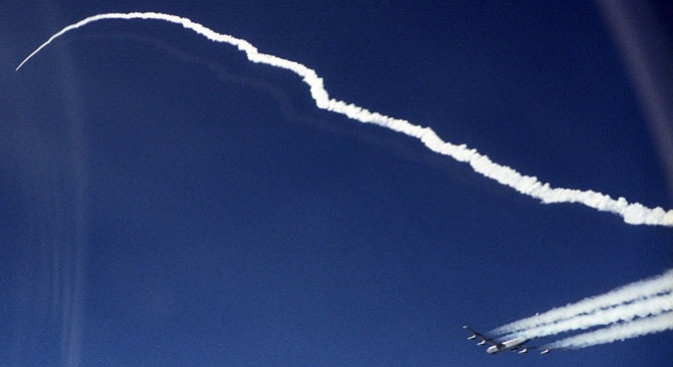

The second X-43A hypersonic research aircraft and its modified Pegasus booster rocket accelerate into the stratosphere after launch from NASA's B-52B launch aircraft over the Pacific Ocean on March 27, 2004
.
On March 27, 2004, NASA’s X-43A shattered existing speed records for aircraft with air-breathing engines when the scramjet-powered vehicle reached a speed of Mach 6.83 (4,900 mph) during a brief flight over the Pacific Ocean. The record speed was more than twice as fast as the SR-71 Blackbird, which could cruise at Mach 3.32 (2,193 mph), and bested even the rocket-powered X-15A-2, which reached Mach 6.7 (4,520 mph) in October 1967.
Perhaps most significant, this was the first time a scramjet engine – a ramjet configuration that allows supersonic airflow through the combustion chamber – was used to accelerate a vehicle in flight.
Having exhausted its small amount of hydrogen fuel, the autonomously operated X-43A, a subscale craft with no onboard crew, performed a series of maneuvers that collected hypersonic aerodynamic data that was telemetered back to a control room at what was then NASA's Dryden Flight Research Center. Finally, the X-43A plummeted into a planned impact zone within the Pacific Missile Test Range. Researchers from both Dryden and NASA’s Langley Research Center, Hampton, Va., eagerly studied this data and compared it with predictive models in the ensuring months.
The flight was part of an ambitious program to advance research in high-speed air-breathing propulsion technologies from laboratory experiments to flight test. The multi-year effort, called Hyper-X, was aimed at conducting flight research in the hypersonic speed regime – above Mach 5, or more than 3,600 mph.
Brad Neal served as lead operations engineer for the program at NASA Dryden, recently renamed in honor of former astronaut and flight research pilot Neil A. Armstrong. Now chief engineer at NASA Armstrong, Neal looks back at the Hyper-X achievements with pride.
“It was the first demonstration of an integrated scramjet in atmospheric flight,” he recalled. “Nothing like that had ever been attempted before.”
An earlier flight in June 2001 was cut short due to a malfunction of the booster rocket used to propel the craft to scramjet ignition speeds. Following the successful second flight, a third and final test of the X-43A on November 16, 2004, achieved a new record speed of Mach 9.68 (6,600 mph).
oel Sitz, currently Deputy Associate Director for Programs at NASA Armstrong, managed flight-testing of the X-43A from July 1998 to December 2004.
"The successful Hyper-X flights were the aeronautical equivalent of landing on the moon,” he said. “We had to overcome tremendous technical and operational challenges.”
Sitz believes the Hyper-X accomplishments have opened up the hypersonic frontier.
“Scramjets have now been proven to work and turbine technology is maturing with materials designed to withstand temperatures at Mach 4, the transition region for converting to ramjet or scramjet propulsion through Mach 10 and beyond,” Sitz noted. A turbine-based, combined-cycle propulsion system could be used to power an aerospace vehicle capable of taking off and landing on a conventional runway, potentially lowering launch costs while increasing mission flexibility. Developing and testing such a system would be a significant scientific and engineering challenge.
“We need to integrate all these propulsion cycles and see what can be discovered,” he concluded.
.
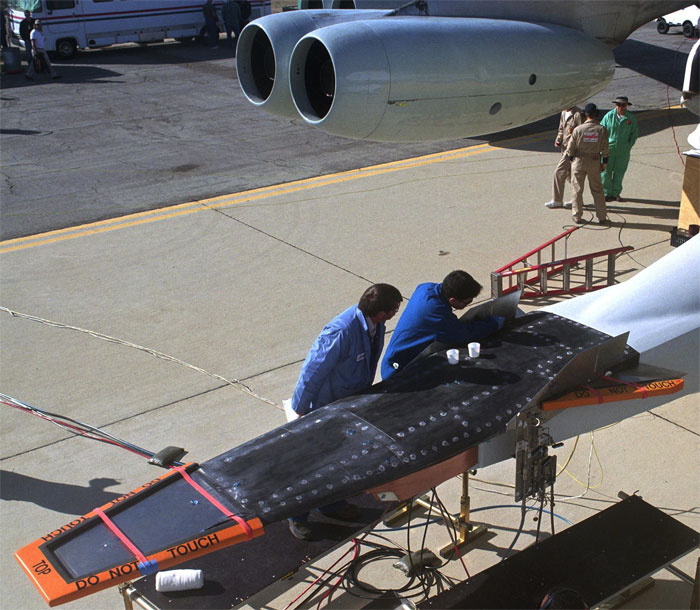
Ground crewman perform final closeout checks on the second X-43A hypersonic research vehicle mounted on its Pegasus booster rocket adapter under the right wing of the NB-52B launch aircraft prior to its record-breaking Mach 7 flight.
Image Credit: NASA / Tony Landis
.
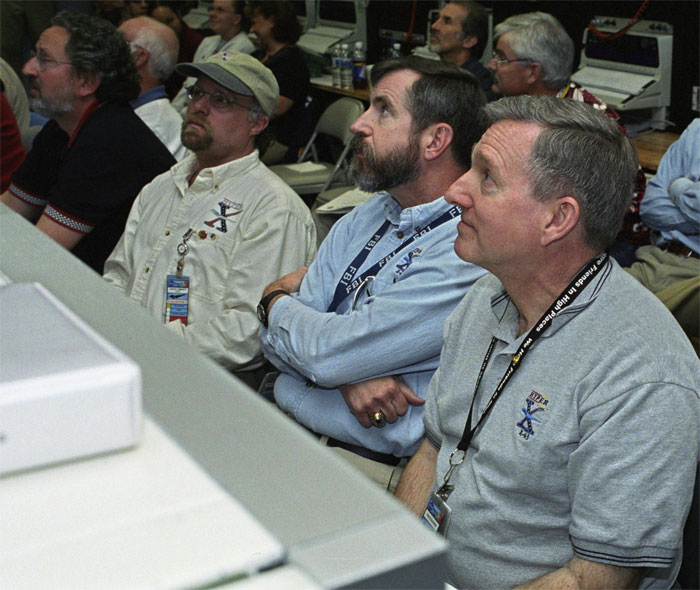
Hyper-X personnel in a control room await the launch of the X-43A. Front row from left: Randy Voland, LaRC Propulsion; Craig Christy, Boeing Systems; Dave Reubush, NASA Hyper-X Deputy Program Manager; and Vince Rausch, NASA Hyper-X Program Manager.
.
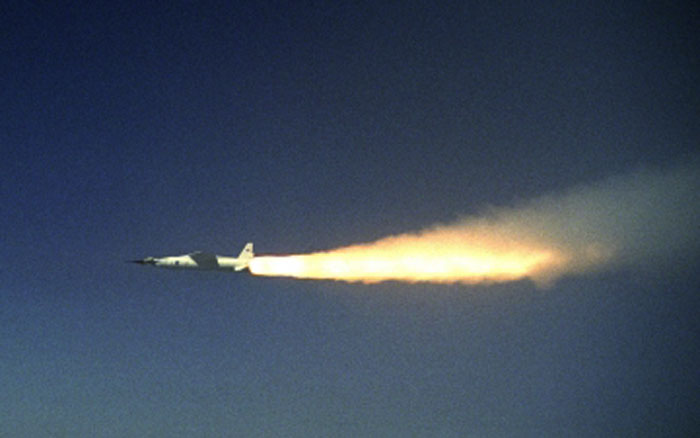
A modified Pegasus booster rocket ignites moments after release from the B-52B, beginning the acceleration of the X-43A over the Pacific Ocean in March of 2004. The X-43A vehicle is mounted on the nose of the rocket.
.
X-43A Flight Makes Aviation History
NASA made aviation history with the first and second successful flights of a scramjet-powered airplane at hypersonic speeds - speeds greater than Mach 5 or five times the speed of sound. Compared to a rocket-powered vehicle like the Space Shuttle, scramjet (supersonic combustion ramjet) powered vehicles promise more airplane-like operations for increased affordability, flexibility and safety for ultra high-speed flights within the atmosphere and into Earth orbit. Because they do not have to carry their own oxidizer, as rockets must, vehicles powered by air-breathing scramjets can be smaller and lighter - or be the same size and carry more payload.
Researchers have worked for decades to demonstrate scramjet technologies, first in wind tunnels and computer simulations, and now in an airplane in flight. Ultimate applications include future hypersonic missiles, hypersonic airplanes, the first stage of two-stage-to-orbit reusable launch vehicles and single-stage-to-orbit reusable launch vehicles.
High-Risk, High-Payoff Program
The eight-year, approximately $230 million NASA Hyper-X program was a high-risk, high-payoff research program. It undertook challenges never before attempted. No vehicle powered by an air-breathing engine had ever flown at hypersonic speeds before the successful March 2004 flight. In addition, the rocket boost and subsequent separation from the rocket to get to the scramjet test condition had complex elements that had to work properly for mission success. Careful analyses and design were applied to reduce risks to acceptable levels; even so, some level of residual risk was inherent to the program.
Hyper-X research began with conceptual design and wind tunnel work in 1996. Three unpiloted X-43A research aircraft were built. Each of the 12-foot-long, 5-foot-wide lifting body vehicles was designed to fly once and not be recovered. They are identical in appearance, but engineered with slight differences that simulate variable engine geometry, generally a function of Mach number. The first and second vehicles were designed to fly at Mach 7 and the third at Mach 10. At these speeds, the shape of the vehicle forebody served the same purpose as pistons in a car, compressing the air as fuel is injected for combustion. Gaseous hydrogen fueled the X-43A.
The Record-Breaking Flight
After the first flight attempt in June of 2001 failed when the booster rocket went out of control, the second and third attempts resulted in highly successful, record-breaking flights. Mach 6.8 was reached in March of 2004, and Mach 9.6 was reached in the final flight in November of 2004.
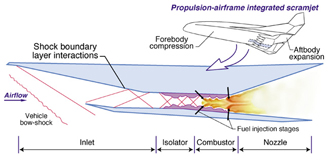
At nearly 5,000 mph, the March flight easily broke the previous world speed record for a jet-powered (air breathing) vehicle. The X-43A research vehicle was boosted to 95,000 feet for a brief preprogrammed engine burn at nearly Mach 7, or seven times the speed of sound. During its third and final flight - at nearly Mach 10 - the X-43A research vehicle flew at approximately 7,000 mph at 110,000 feet altitude, setting the current world speed record for an air-breathing vehicle.
The Mach 10 research vehicle featured additional thermal protection, since expected heating was roughly twice that experienced by the Mach 7 vehicle. Carbon-carbon composite material, for instance, was added to the leading edges of the vehicle's vertical fins to handle the higher temperatures.
Both flights began with the stack being carried by a B-52B aircraft from NASA's Dryden Flight Research Center to a predetermined point over the Pacific Ocean, 50 miles west of the Southern California coast. Release altitude from the B-52B was 40,000 feet for both successful flights. At that point, each stack was dropped from the B-52B, and the booster lifted each research vehicle to its unique test altitude and speed.
Other than differences of altitude, speed and distance covered, the Mach 10 flight profile followed that of the Mach 7 flight: The Mach 10 research vehicle separated from the booster and flew under its own power and preprogrammed control. It was separated from the booster rocket by two small pistons. Shortly after separation, its scramjet engine operated for about ten seconds obtaining large amounts of unique flight data for an airframe-integrated scramjet. The engine thrust was very close to its design value in each flight - sufficient to accelerate the vehicle during the Mach 7 flight and to allow the vehicle to cruise at constant velocity in the Mach 10 flight.
In each case, when the scramjet engine test was complete, the vehicle went into a high-speed maneuvering glide and collected nearly ten minutes of hypersonic aerodynamic data while flying to a mission completion point, hundreds of miles due west (450 miles at Mach 7, 850 miles at Mach 10) in the Naval Air Warfare Center Weapons Division Sea Range off the southern coast of California. Each vehicle splashed into the ocean, as planned, and was not recovered.
Guinness World Records has recognized both the Mach 6.8 and Mach 9.6 accomplishments and has listed the flights on their web site and in the 2006 edition of their book of records. Prior to the 2004 X-43A flights, the previous record was held by a ramjet-powered missile that achieved slightly over Mach 5. The highest speed attained by a rocket-powered airplane, NASA's X-15 aircraft, was Mach 6.7. The fastest air-breathing, crewed vehicle, the SR-71 achieved slightly over Mach 3. The X-43A more than doubled the top speed of the jet-powered SR-71.
2001 Flight and Investigation
The first flight attempt of the X-43A was in June of 2001. Unfortunately, the booster failed and had to be destroyed early in flight. As a result, the research vehicle was not tested because it never reached test conditions. Although no single contributing factor was found, the root cause of the problem was identified as the booster's flight control system. The booster failed due to inaccurate design models that overestimated the capability of the flight control system to operate within predicted flight conditions.
The Hyper-X program has significantly expanded the boundaries of air-breathing flight by being the first to fly a "scramjet" powered aircraft at hypersonic speeds. Numerous actions were taken in response to the findings. Wind tunnel tests were conducted to provide data to reduce atmospheric loads on the booster's control surfaces, more powerful booster fin actuators were added to overcome aerodynamic loads, and propellant was machined out of the Pegasus booster to enable launch at its normal launch altitude of 40,000 feet instead of 23,000 feet - as on the first flight - in order to reduce aerodynamic loads.
How Scramjets Work
A ramjet operates by subsonic combustion of fuel in a stream of air compressed by the forward speed of the aircraft itself, as opposed to a normal jet engine, in which the compressor section (the fan blades) compresses the air. Ramjets operate from about Mach 3 to Mach 6.
A scramjet (supersonic-combustion ramjet) is a ramjet engine in which the airflow through the engine remains supersonic. Scramjets powered vehicles are envisioned to operate at speeds up to at least Mach 15. Ground tests of scramjet combustors have shown this potential, but no flight tests have surpassed the Mach 9.6 X-43A flight. See illustration below.
.

Image above: This simplified graphic illustrates how air and fuel mix at supersonic speeds inside a scramjet engine to propel the vehicle to many times the speed of sound. Supersonic speeds are greater than the speed of sound.
.
Langley and Dryden - A Joint Effort
The Hyper-X Program, managed by the Aeronautics Research Mission Directorate in Washington, was conducted jointly by the Langley Research Center, Hampton, VA, and the Dryden Flight Research Center, Edwards, CA. Langley was lead center, responsible for hypersonic technology development. Dryden was responsible for flight research, hardware integration, and testing.
NASA's Aeronautics Research Mission Directorate develops tools and technologies that can help transform how the air transportation system operates, how new aircraft are designed and manufactured, and how our Nation's air transportation system can reach unparalleled levels of safety.
ATK GASL (formerly MicroCraft, Inc.), Tullahoma, TN and Ronkonkoma, NY, built the three X-43A research aircraft and engines. Boeing Phantom Works, Huntington Beach, CA, designed the thermal protection and onboard systems. The booster was a modified Pegasus rocket built by Orbital Sciences Corp., Chandler, AZ.
.
Quelle: NASA
5033 Views

